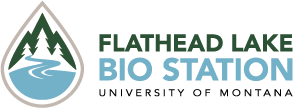More Teaching Material
Ecology Lessons
These lessons were designed for grades K-12.
Creation of these lessons was supported by the Flathead Lake Biological Station.
Connecting with Monitoring Montana Waters
Overview
Have you ever wondered what's happening in Montana's streams? Take a closer look at stream data from across Montana and the United States to learn more about these important river ecosystems.
Accessing Data
Detecting AIS with eDNA
Overview
In this lesson, students will be introduced to how scientists detect and monitor Aquatic Invasive Species by comparing visual AIS detection with the processes of eDNA sampling, Polymerase Chain Reaction (PCR), and DNA Sequencing.
Lesson Plan
Detecting AIS with eDNA Lesson Plan
Presentation
Detecting AIS with eDNA Presentation
Additional Material
*Teachers, if you are interested in obtaining the answer key for the Search and Find activity or DNA strip identification, please contact us at edoutreach@flbs.umt.edu.
Discovering Data
Overview
The resources below will walk you through how to access public stream data from the Montana State University Extension Water Quality Program website and the National Water Quality Monitoring Council's Water Quality Portal. Additionally, you can find instructions on how to access lake, weather, and tributary data collected by Flathead Lake Biological Station scientists.
Public Stream Data
FLBS Data
Food Web Dynamics (Kindergarten to 5th grade)
Overview
Students are introduced to what all plants and animals have in common and what they both need to survive. During this activity they will build a lake food chain and food web, as well as, learn how all organisms in the lake ecosystem are interconnected.
Lesson Plan
Food Web Dynamics_Kto5 lesson plan
Presentation
Food Web Dynamics (6th to 12th grade)
Overview
Students build a lake food web, learn how all organisms in the lake ecosystem are interconnected, and explain the roles phytoplankton and zooplankton play in the lake ecosystem as primary producers and consumers.
Lesson Plan
Food Web Dynamics_6to12 Lesson Plan
Note- This lesson was designed for students to complete (in class) prior to attending a Lake Ecology field trip at the Bio Station.
Water Cycle Unit (5th to 8th grade)
Overview
Students will be introduced to the water cycle from both a local and global perspective, as well as, participate in hands-on inquiry stations, an online water cycle exploration activity, and a teacher-led presentation that will aid vocabulary acquisition and use. Students demonstrate their understanding of the water cycle by building a 3-D model that represents how the water cycles through a specific biome found on Earth.
Unit Summary
Pre and Post-Unit Quizzes
Water Cycle Vocabulary Quizzes
Unit Lessons
Lesson #1: Water Cycle Inquiry: Explore the processes of the water cycle with five hands-on activities.
Water Cycle Inquiry Stations Lesson Plan
Lesson #2: Water Cycle Vocabulary Foldable: Learn the unit vocabulary by creating and using the foldable flashcards.
Water Cycle Vocabulary Foldable Lesson Plan
Water Cycle Vocabulary Foldable Presentation
Lesson #3: Water Cycle Around the World: Find and record evidence of the water cycle around the world using Google MyMaps.
Water Cycle Around the World Lesson Plan
Lesson #4: Four Seasons of the Water Cycle: Learn about how the Earth's tilt and rotation around the sun create uneven heating of the Earth's surface. The uneven heating impacts the global water cycle and the distribution of biomes on Earth.
Four Seasons of the Water Cycle Lesson Plan
Four Seasons of the Water Cycle Presentation
Lesson #5: Water Cycle 3-D Model: Demonstrate your understanding by designing and building a functional 3-D model of a water cycle that represents a specific biome on Earth.

